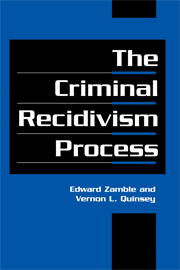Book contents
- Frontmatter
- Contents
- List of Illustrations and Tables
- Preface
- 1 Introduction: The Prediction of Criminal Behavior
- 2 The Study
- 3 Recidivists: A General Profile
- 4 Comparisons with Nonrecidivists
- 5 Comparisons across Offender Groups
- 6 Comparisons within Offender Groups
- 7 Final Considerations
- References
- Appendix: Interview Form
- Index
5 - Comparisons across Offender Groups
Published online by Cambridge University Press: 02 February 2010
- Frontmatter
- Contents
- List of Illustrations and Tables
- Preface
- 1 Introduction: The Prediction of Criminal Behavior
- 2 The Study
- 3 Recidivists: A General Profile
- 4 Comparisons with Nonrecidivists
- 5 Comparisons across Offender Groups
- 6 Comparisons within Offender Groups
- 7 Final Considerations
- References
- Appendix: Interview Form
- Index
Summary
the preceding chapters have elucidated some aspects of the transition to recidivism, but the picture is still fragmentary. In several areas of inquiry we received information about a variety of specific events in subjects' lives and thoughts, such as the changes in specific emotional states occurring just before the new offence or the motives for a return to criminal behavior. It is possible that this shows only the variability inherent in the offence process but more likely that at least some of the variance in the overall sample comes from grouping together many sorts of offenders, with diverse current experiences and varying behavior patterns. We will argue that different sets of specific psychological events are associated with different types of current offences.
It has often been noted (for example, Gottfredson and Hirschi, 1990) that a large proportion of repeat offenders commit a variety of types of crimes. Some of the men in our sample had at some time committed all of the types of crimes according to which subjects were grouped in this study. However, the observation that these men are not specialists says nothing about whether there are unique dynamic antecedents of particular types of crimes. Rather, the latter question is best addressed by comparing the antecedents across their most recent offences, as is done here.
In terms of our understanding of the recidivism process, probably the most important question here is that of the specificity of the dynamic antecedents we have seen in the preceding chapters.
- Type
- Chapter
- Information
- The Criminal Recidivism Process , pp. 95 - 118Publisher: Cambridge University PressPrint publication year: 1997

